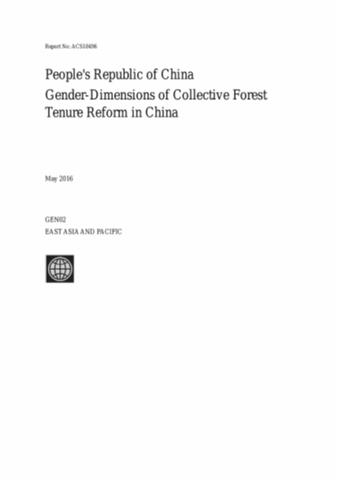Resource information
The reform of China's collectively owned forest land, began in 2008, is arguably the largest land-reform undertaking in modern times in terms of area and people affected. Under the reform, forest lands have been contracted to rural households, allowing them more independence in exercising their rights and interests in the forest lands, giving them more opportunities to improve family incomes, and creating incentives for them to cultivate, conserve, and manage forests. These lands are home to some 610 million people, many of them poor. With urbanization, vast numbers of Chinese men have migrated to cities to work, leaving women as the predominant labor force in rural areas. Indeed, some 70 percent of China’s agriculture labor force is now female. The immense scope of this change calls for a systematic examination of how China's rural women gain access to and exploit forest land and associated resources and services. The reform was designed to unfold in two broad stages. In the first, collectively owned forest lands suitable for contracting were allocated on equal terms to each household in affected villages. The ongoing second stage represents a deepening of the reform. It deals with subsidies and ecological compensation, financial services (including use of forest tenure as collateral and transfers of forest land), forest insurance, technical services and training, farmers’ associations and cooperatives, and market services. However, the monitoring had not covered the gender dimension of the reform, meaning that the gender data required to accurately reflect the full effects of the reform have been lacking. Building on the annual monitoring conducted by the FEDRC, the study reported here added gender-related investigation and analysis to obtain gender data about the current reform situation, its problems, and their causes. It also included structured interviews with rural women and group meetings with local government agencies, women’s federations, and village committees.The ultimate objective of the study is to achieve better gender-responsiveness in China’s collective forest tenure reform. Specifically, this includes: (i) equality in access to and control of forest lands, as well as access to associated resources and services; (ii) women’s participation and equality in decision-making concerning the conservation and utilization of forest resources; and (iii) impacts of the first two aspects on the status and well-being of women. The World Bank has had over 30 years of successful cooperation with China in the forestry sector. Women’s access to the services and resources that are the focus of the second stage of the reform will be a critical element of the World Bank’s continuing reform dialogue with its Chinese partners.


